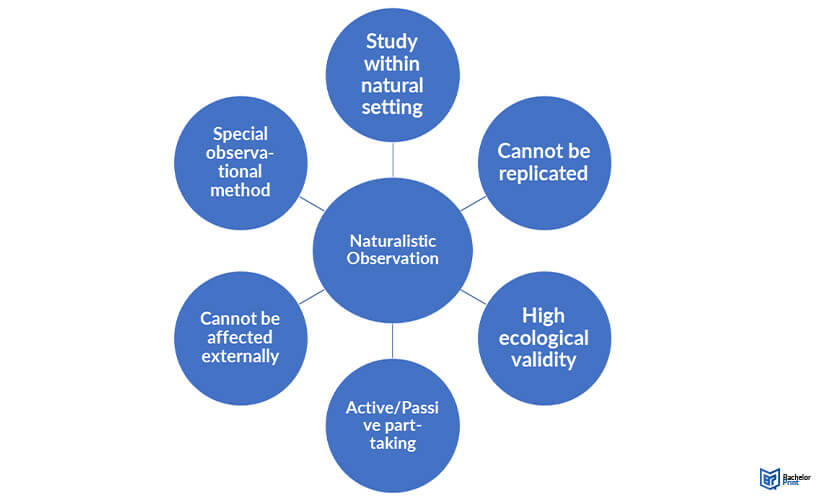
Naturalistic observation, a methodology rooted in non-experimental research, involves studying entities within their authentic environments. Often leveraged during the preliminary phases of a research initiative, it forms the basis for hypotheses that may subsequently undergo experimental testing.
Being a method that typically necessitates researchers to venture into real-world scenarios, it’s also referred to as fieldwork. This approach presents a unique opportunity for data collection, allowing for the gathering of natural occurrences without the observer’s interference.
Definition: Naturalistic observation
Naturalistic observation is a primarily qualitative research methodology used in psychology and other social sciences to observe participants in their natural environment. This method observes subjects of interest in their natural, everyday setting.
A famous example of this method was when the zoologist Konrad Lorenz observed ducklings and goslings as they hatched and took detailed notes on their behavior.
Types of Naturalistic Observation
A researcher can conduct naturalistic observation in the following ways:
-
Non-participant or participant:
- The researcher can participate in the activity or can observe from a distance
-
Overt or covert:
- The researcher can reveal their identity as an observer to the participants, or they can hide it.
| Non-participant observation | Participant observation | |
| Overt observation | • The research participants know that they are being observed. • Participants are observed from afar |
• The participants know that they are being observed. • The researcher also takes part in the activity that they are researching |
| Covert observation | • The research participants are neither told nor shown that they are being observed. • Participants are observed from afar. |
• The participants are not told that they are being observed to prevent influencing their behavior. • The researcher involves themselves in the activity that they are researching |
Naturalistic observation: Data collection
There are several methods you can use to collect data for naturalistic observation. These include:

Tally counts
Tally counts sampling happens when a researcher records a tally every time an event occurs. It helps note down the frequency at which a specific behavior or event occurs.
Observer Narrative
This method occurs when the researcher takes detailed notes throughout their observation for later referral. Anything essential or relevant based on the research topic is noted down in an unstructured way.
The researcher can use these notes to write a research paper or outline specific behaviors they observed.


Audio-visual recordings
If appropriate, researchers can collect observations using audio and video recordings. These recordings can be revisited later, compared with older observations, and shared with other trained observers to recognize differences or track progress.
However, when using this method, researchers must be careful to obtain written consent from all the participants before beginning to record. The recording devices should also be placed discreetly to prevent distracting the participants.
Naturalistic observation: Data sampling
It is seldom feasible nor possible to collect data from every moment of a subject’s life. Researchers usually use data sampling to gather information. Sampling aims to ensure that the data collected is representative of the participant’s overall behavior.
A researcher can collect a representative sample through several methods, including:
Event sampling
This approach includes recording observations only when specific events occur. A tally count can be used to note the frequency of occurrence. Event sampling allows researchers to identify better any patterns that are present.
Time sampling
Time sampling involves taking samples at different time intervals. This sampling can be random (with random, periodic intervals) or systemic (with a fixed periodic interval).
Behaviors of interest that occur during these periods are recorded. Time sampling helps researchers identify common routines the participants keep, which can help them develop research on common patterns.
Situation sampling
Situation sampling happens when researchers observe participants’ behavior in different situations and settings. An example of situation sampling would be when a researcher observes an adult at the workplace, the community, and other locations. This method helps determine if certain behaviors are only occurring in specific settings.

Pros vs. Cons of naturalistic observation
There are several advantages to using naturalistic observation, which include:
✓ Advantages
Flexibility
Validity of data collected
Reliability of the results collected
Since naturalistic observation is non-experimental, the researcher is not bound or limited by strict protocols that need to be followed. If they feel that a different approach would yield better and more reliable results, they can change their approach midway.
Because the observed behavior happens in natural settings, this gives the data collected a higher degree of ecological validity than might be achieved with other research methods. This method taps directly into the behavior of interest without relying on interpreting proxies of behavior.
If the researcher can preserve the principle of inconspicuous observation, they can get more reliable and authentic results. Naturalistic observation will allow the researcher to identify patterns and behaviors that may have been difficult or impossible to observe in a lab setting. This gives better insight into normal social behavior as subjects may react differently in a natural environment than when in a clinical setting.
✗ Disadvantages
Despite being valuable in certain situations, naturalistic observation has several disadvantages, which include:
Generalizability
Observer bias
Difficult to set up and observe
Naturalistic observation studies require reproducible protocols, extensive observer training, sufficient resources, and proper study designs to give generalizable and valid results. If the design is flawed, the results cannot be generalized. Besides appropriate study designs, the study will be useless if the methods used are not reliable or valid.
Because the data in naturalistic observation is collected indirectly, there is always a risk of the researcher skewing their observations to fit the research goals. The perceptions and behavior interpretations of the researcher may also be influenced by their own experiences and not reflect the truth. This bias is especially likely to occur when using participant observation methods.
Researchers using Naturalistic observation usually have no control over when they have behavior to observe. Since the research is conducted in the natural environment, controlling the setting and other variables is difficult.
This research type also requires significant money, time, and effort investments.
FAQs
The goal of naturalistic observation is to allow the observers to directly observe a subject in its natural setting without manipulating the environment.
Naturalistic observation is valuable because of the validity of the results carried out using this method, its flexibility, and the reliability of the results collected.
Some disadvantages include observer bias, difficulty setting up and collecting data, and the generalizability of the data collected.
The tactics a researcher can use to limit observer bias include:
- Training the observers to ensure consistent recording of data between them.
- Using several observers to ensure interrater reliability.
- Hiding or masking the purpose of the study from all observers.
Some professionals who use this method in their field include teachers, medical professionals, law enforcement officers, and wildlife biologists.
